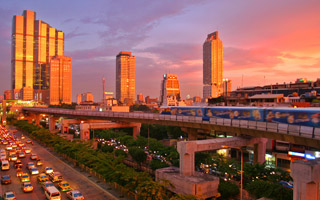 |
| Skytrain |
 |
| Metro |
 |
| Taxi |
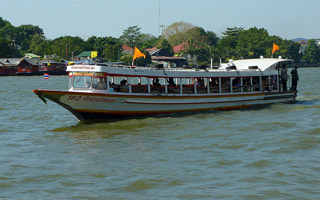 |
| Chao Phraya Express Boat |
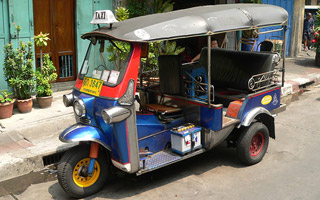 |
| Tuk tuk |
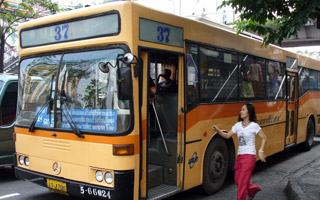 |
| Bus |
| Motorbike taxi |
 |
| Suvarnabhumi airport |
 |
| Eastern bus terminal |
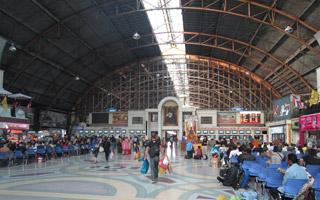 |
| Hualamphong |
Sky Train The Skytrain, known locally as the BTS, is the best thing to happen to public transport in Bangkok. It has taken a lot of people off the roads and reduced congestion and pollution. There are two main lines that intersect and join much of the city up. The one important area not on the Skytrain is Khao San. Check out the link below for information for BTS timetables. The Sky Train uses an automated token system that is yet to be integrated with the underground Metro. Trains from 6.30am to midnight. Fares start at 15 Thai Baht. It is possible to get 1-day pass for 130 THB. Most station have elevators for families with pushchairs. Resource: www.bts.co.th Metro The Metro, or MRT, consists of 20 kilometers of track running under the city. There are plans to expand the underground. At present it has 18 stations and runs in a wide semi-circle from Hualamphong in the south (the main train station) to Bang Sue in the north. As with the Skytrain the metro is fast, clean, punctual and reasonably priced for tourists (sadly it is too expensive for many locals). The MRT connects with the Skytain at Silom, Sukhumvit and Chatuchak. Trains run from 6am to midnight. Fares start at 20 THB. Day passes cost 120 THB. Most stations have elevators and escalators. Resource: http://bangkok.sawadee.com/mrta.htm Taxis Taxi cabs are yellow in Bangkok. Most taxi drivers in Bangkok are friendly and honest. They might not speak much English but you should be able to point to the meter and understand if he is willing to take you for a metered charge. Generally taxi drivers outside the big hotels, the main tourist attractions and Khao San Road will take you anywhere for the correct price. Some drivers are reluctant to make certain journeys during rush hours (8.30 am to 10 am & 4 pm to 7pm). Also be aware that Sukhumvit Road is a busy road with 3 lanes going each way. It is difficult for drivers to change direction - it is easier for you to cross the road. People often think that tuk tuks must be cheaper than taxis. They are wrong. Tuk tuk drivers don't have meters and will try and charge as much as possible. With 4 people in a taxi the fare is often cheaper than tuk tuks, BTS or MRT. Chao Phraya Express Boat The main river running through Bangkok is called the Chao Phraya. There are also a number of smaller canals called Klongs running off the main river course. Until the Twentieth Century the river was the main means of transport for Bangkok. That is why the main temples and palaces are located along the river. It is easy to jump on and off express boats. They regularly run up and down the river. The best boats to catch are those with an orange flag. You pay between 10 THB and 30 THB a journey. There are two main advantages of the express boats - first they are a great way to see the city and offer a cool breeze. Secondly, they link Khao San and the old Bangkok area to the Sky Train. An important pier is Sathorn Pier that is a short distance from Saphan Thaksin BTS. Other important piers are Tha Tien (Grand Palace) and Phra Ahtit (Khao San). There are some great tours of the city by chartered boat. Resource: www.chaophrayaexpressboat.com Tuk Tuks If you are a small family you might be able to fit in the back of a 3 wheel scooter taxi commonly called a tuk tuk. It is a fun experience. The small vehicles are great for weaving in and out of the traffic. However, the drivers nearly uniformly over-charge foreigners (called 'farang'). Outside places like Wat Pho they will offer to take you anywhere for 10 Baht and end up taking you to 2 or 3 jewellery shops. The longer you stay in Bangkok the less enamoured you will feel about tuk tuks. Important: Always agree a price before heading off. Buses Other than walking buses are the cheapest way to get around the city. You can travel for literally hours for under 20 Baht. Although you can buy bus route maps from small shops they don't make much sense. Best to go to a bus stop you think should be on the route you desire and ask the locals. There are both air-con and non air-con buses available. Unless you are really on a tight budget it is unlikely that you will want to try Bangkok buses. For a start they can be painfully slow during rush hour. Buses in Bangkok are not particularly family-friendly. Motorbike taxis Motorbike taxis are easy to find in Bangkok. They are young men wearing orange vests. They usually gather in groups at the end of busy roads. The video opposite is called 'crazy Bangkok motorbike taxi ride'. Putting aside the bad English, the video gives you a good idea what you let yourself in for getting on the back of a motorbike taxi. I only take them as last resort for short distances. The drivers wear a helmet and you don't. They dodge from lane to lane and sometimes go up on thre pavement and even cut across on coming traffic. You don't need much of an imagination to see all the ways a motorbike taxi ride could end badly for you. Agree fares before you get on. For short distances you can pay as little as 10 Thai Baht. Personally, I would never risk my family hiring a motorbike taxi. They make tuk tuks look safe. Leaving the City Airplane The main international airport is Suvarnabhumi Airport. It was built fairly recently but it already suffers from cracks and sinking - they built it on a swamp. Taxis to and from the airport to Bangkok cost about 500 Thai Baht. Always use the official taxi stand at the airport. The driver will ask you if you want to take the express way or not. You will have to pay the toll of 70 THB. Now there is a cheap train you can catch from Suvarnabhumi into Hualamphong in Chinatown. Another alternative is to take the Airport Express Bus. It is 100 Thai Baht per person. Buses go to either Khao San or Sukhumvit. The bus to Khao San takes 1 hour. Several domestic flights and a few international flights are now using the old Don Meung airport. This airport is slightly closer to the city but still expect to pay 500 Baht for a taxi. Long Distance buses For those who don't take a domestic flight out of Bangkok one of the most common options is a long distance air-con bus. Travel agents in Khao San and Sukhumvit sell them cheaply to places like Khao Lak, Koh Samui and Phuket. Buses to Koh Samui, Koh Phangan and Koh Tao are over night. Bus prices vary between 700 THB and 1,500 THB to get to Koh Phangan. Much cheaper are buses that go from one of the 3 main bus stations in Bangkok Here is a brief summary of bus stations and destinations:
These buses are much slower than chartered buses laid on for tourists. There only advantage is that they are cheap and provide a more 'authentic' Thai experience. Trains Most of the trains leaving Bangkok go from the central train station called Hualamphong. You reserve seats and sleepers through travel agents or at the station. Different classes are as follows: first class sleeper (air-con), second class sleeper, second class seat and third class. Few trains have all these classes available. In first class sleeper you get a 2 bunk carriage, sink and a door that locks from the inside. Beware the air-con is not adjustable and gets very cold at night. The price of a first class sleeper is about the same as a low cost carrier flight and so the most sought after tickets are the second class sleepers. There are plenty of food vendors going up and down the train. Many trains have a dining cart sellingt over-priced food and drink. You can catch trains going north to Chiang Mai, South to Suratthani and Malaysia and East to Cambodia. Travel around South East Asia has become easier over the years. Countries such as Laos and Myanmar have opened up to tourism. Visa regulations have been relaxed and transport connections are getting better. It is now possible to expand the family holiday beyond Bangkok and Thailand. Here are a few resources for South East Asian travel: |

